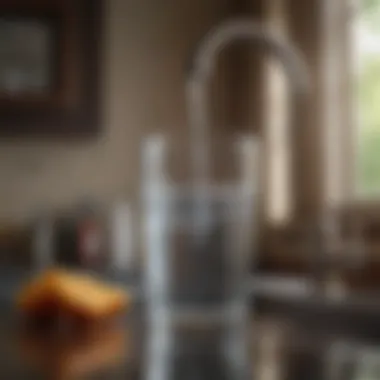Top Under Counter Water Filtration Systems Guide


Intro
Water quality is something that slips under the radar for many, yet it plays a vital role in our daily lives. Having access to clean, pure drinking water should be an absolute given, not a luxury. The journey towards achieving this can often be convoluted, with a myriad of options available on the market. Among them, under counter water filtration systems have gained significant popularity. These systems not only promise enhanced water quality but also integrate seamlessly into your kitchen, providing both aesthetics and functionality.
In this guide, we'll navigate through the intricate landscape of under counter filtration systems. We’ll break down the different types of technologies available, compare popular models, and offer practical installation and maintenance tips. By the end, you'll be equipped with the knowledge necessary to make a well-informed decision, ensuring that your drinking water is not just safe but tastes great, too.
But why should you care? Well, the choices you make can significantly affect your health, environment, and wallet. Understanding the filtration system that suits your lifestyle is crucial, and it starts right here. Let's delve deep into the world of water filtration to discover the best solution tailored for your needs.
Prelude to Under Counter Water Filtration Systems
When it comes to ensuring the purity of drinking water, understanding the role of under counter water filtration systems is of utmost importance. These systems provide a direct way to obtain clean, safe water right from your kitchen sink, making them a valuable addition to any household. By filtering out contaminants, they not only improve water quality but also provide peace of mind for families concerned about the health implications of tap water.
Understanding Water Contaminants
Water, as essential as it is, often carries a hidden assortment of contaminants that could pose a risk to health over time. Common pollutants include chlorine, lead, sediments, pesticides, and microorganisms. Each of these has its own set of potential health risks—ranging from mild digestive issues to serious illnesses. For instance, lead exposure is linked to neurological problems, particularly in children. Such concerns underline the necessity of a reliable filtration system.
By using an under counter water filtration system, households can significantly reduce their exposure to these toxins. The beauty of these filtration systems lies in their ability to tackle a variety of contaminants—some systems use multiple filtration methods to ensure the water is as clean as possible. Regular testing of your water source can shed light on specific contaminants present, thus guiding decisions on the appropriate filtration technology to employ.
Importance of Clean Water in Daily Life
Clean water is foundational for daily living. From cooking to personal hygiene, the quality of water impacts various aspects of life. When families drink filtered water, they immediately notice a difference: the taste is often noticeably improved, and there’s confidence in knowing the harmful chemicals and pollutants are being filtered out.
Moreover, filtered water contributes to overall wellness. Regular access to clean, safe water can reduce the chances of infections and chronic gastrointestinal issues, which can particularly affect young children and the elderly. As many households are increasingly concerned about health and wellness, integrating a filtration system encourages better hydration habits among family members.
"Access to clean water is a right, not a privilege."
Ensuring that your family has access to safe drinking water should never be taken lightly. The convenience of an under counter water filtration system allows easy integration into kitchen spaces without taking up much room, providing a constant, ready source of pure water. As such, they have become not just a luxury, but almost a necessity in today’s modern households.
Types of Under Counter Water Filtration Technologies
Selecting the appropriate under counter water filtration technology can be a game-changer for ensuring the quality of drinking water. Various systems employ distinct methods, and understanding each one’s benefits and drawbacks is paramount for making an informed choice. Here, we’ll delve into the different types of filtration techniques, shedding light on their unique mechanisms. This way, you will have the necessary knowledge to decide based on your specific needs and concerns regarding water quality.
Reverse Osmosis Systems
Reverse osmosis systems are often seen as the gold standard in water filtration. This technology works by pushing water through a semi-permeable membrane that acts like a microscopic sieve, trapping contaminants and allowing only clean water to pass through. The extensive removal capabilities of reverse osmosis systems can effectively eliminate a wide range of impurities, including heavy metals, salts, and microorganisms.
However, these systems do require a bit of maintenance and the initial investment can be on the higher side. Moreover, they tend to waste some water during the filtration process, which is a consideration for those looking to conserve water in their homes. Ultimately, if purity is your utmost priority, reverse osmosis might be the way to go.
Carbon Filtration Methods
Carbon filtration is another popular choice for under counter water systems. These filters utilize activated carbon to absorb chemicals, improving taste and odor while reducing chlorine, sediment, and volatile organic compounds. Quite possibly the most user-friendly option, carbon filters not only enhance the flavor of drinking water but also are relatively easy to replace and maintain.
However, it's important to keep in mind that carbon filters may not capture all contaminants, particularly certain minerals and metals. Therefore, they are often best suited for consumers primarily interested in taste enhancement over comprehensive purification. If you're looking for something efficient that doesn't break the bank, you might want to consider carbon filtration.
Ultraviolet (UV) Filtration
Ultraviolet (UV) filtration systems employ UV light technology to disinfect water. This method is particularly effective at killing harmful bacteria, viruses, and other microorganisms without adding any chemicals or altering water taste. The beauty of UV purification is its speed and efficiency. In a matter of seconds, harmful pathogens can be neutralized, making your water safe to drink.
However, UV systems do require electricity to operate and are not effective against physical contaminants or heavy metals. This can be a drawback if your water source is known to contain such issues. Still, for households concerned about microbial contamination, UV filtration represents a modern and innovative solution worth considering.
Ceramic Filtration
Ceramic filtration is a lesser-known but equally valid choice for those wanting an effective water filtration solution. This method uses a porous ceramic material to filter out bacteria and sediment. Its outstanding feature is that it doesn't require any electricity, making it a viable option for areas where power supply is inconsistent. Additionally, ceramic filters typically have a longer lifespan.


On the flip side, ceramic filters are generally only effective against larger contaminants and may not capture smaller particles or chemical impurities. They can, however, be an excellent supplementary filtration method alongside others to ensure a well-rounded approach to water purity. Choosing ceramic filtration can be a practical option if you're looking for sustainability and reliability.
In summary, each type of water filtration technology offers its own distinct advantages and challenges. By understanding these, you can align your choice with your health needs, budget, and lifestyle.
Key Features to Consider
When it comes to choosing an under counter water filtration system, it's crucial to understand what features matter most for your unique situation. With so many options on the market, knowing which aspects to prioritize can make all the difference. Let's dive into four key features that stand out: filtration capacity and speed, maintenance requirements, size and space considerations, and cost and warranty options.
Filtration Capacity and Speed
Filtration capacity refers to how much water a system can filter before needing a new cartridge or maintenance. If you have a busy household, a model with a high capacity can save you from frequent replacements, which not only reduces long-term costs but also ensures you always have access to clean drinking water. Speed, on the other hand, indicates how quickly the system can provide filtered water. It’s often quite frustrating when you're waiting for your glass of water to fill up. A slow system can dampen your experience, especially during busy mornings or family gatherings.
Always consider the daily water demands when choosing filtration systems—nobody wants to wait forever for a glass of water!
Maintenance Requirements
No one likes to constantly tinker with their household appliances. Understanding the maintenance requirements of a water filtration system is key to ensuring it remains operational without much hassle. Some systems, like reverse osmosis units, may require regular filter changes and servicing, while simpler carbon filters might only need an occasional replacement. Regular upkeep ensures that the system functions effectively, ultimately leading to a longer lifespan and better water quality—all without giving you a headache. Be sure to read the manufacturer’s recommendations and check the availability of replacement filters.
Size and Space Considerations
Size and space considerations are often overlooked until it’s too late. Under counter systems need sufficient room for installation, as you’ll be placing them beneath your sink. Some spaces are tighter than others, affecting what model fits comfortably. Measure your available space before you commit to a purchase. Compact models might be suitable for smaller spaces, while larger units could sacrifice valuable storage if not managed correctly. Make sure your preferred model will fit and leave enough room for plumbing connections.
Cost and Warranty Options
Cost and warranty options can vary dramatically among water filtration systems. It's tempting to pick the cheapest model available, but that may not guarantee the best quality or longevity. A higher upfront cost often correlates with effective filtration performance and long-term reliability. Equally essential is the warranty—knowing that your investment is protected can bring peace of mind. Make sure to check what the warranty covers, as this may include parts, labor, or specific defects, providing insight into the manufacturer’s trust in their product.
Top Models of Under Counter Water Filtration Systems
Selecting the right water filtration system is not merely about having filtered water at your disposal; it’s also about ensuring that you put your hard-earned money into a product that delivers results. In the crowded marketplace of under counter water filtration systems, choosing the right model can feel overwhelming at times. Understanding the top models in this category will help you navigate through various options, allowing you to weigh the pros and cons of each. The following sections will break down three standout systems, their performances, and real user feedback, providing insights that are essential for making a well-informed choice.
Model A: Overview and Performance
Model A stands tall among water filtration systems and garners attention for its impressive performance metrics. This model employs a reverse osmosis filtration technology, renowned for its ability to remove up to 99% of contaminants, including lead, chlorine, and other harmful substances. Its three-stage filtration process begins by sediment filtration, eliminating larger particles, followed by activated carbon filtration, which tackles finer impurities, and finally, the reverse osmosis membrane completes the purification cycle.
Users have noted that the flow rate of Model A meets daily needs without missing a beat. Whether you’re filling a pot for pasta or just grabbing a glass of water, it provides a steady stream. Its compact design ensures it can fit snugly under most sink cabinets without hogging too much space. The blend of performance and easily navigable features makes this model attractive for any homeowner.
Model B: Advantages and Limitations
Model B brings its own set of advantages to the table. One of the primary benefits is its carbon filtration methodology, which not only removes bacteria and particles but also enhances the taste of water by eliminating unpleasant odors and flavors. For many, this is a game-changer when it comes to the overall drinking experience. Moreover, the installation process is user-friendly, often described as a simple weekend project.
However, it’s not all sunshine and rainbows with Model B. Some users have reported that while the filtration capability is solid, the replacement filters can be somewhat expensive over time. This is a noteworthy consideration for budget-conscious homeowners. Furthermore, the system's effectiveness might lessen without a regular maintenance schedule, which could lead to more considerable expenses in the long run.
Model C: User Reviews and Recommendations
User feedback often paints a vivid picture of any product’s real-world performance, and Model C has captured user hearts and minds to a significant degree. Reviewers on platforms like Reddit frequently praise its durability and ease of use. Many highlight that the initial setup was intuitive and that customer service was responsive when queries arose.
"Model C has been a game changer for our family’s health. We drink more water now, and our kids are healthier!" – a satisfied customer.
One common recommendation is to keep an eye on the filter change indicators that Model C provides; timely replacements ensure optimal performance. On the flip side, a few users have mentioned concerns over the warranty support, citing that they experienced delays in service. However, overall, Model C comes highly recommended for those prioritizing efficiency and longevity in their water filtration needs.
In summary, exploring the top models of under counter water filtration systems illuminates the path towards enabling cleaner, safer drinking water. It’s not just about purchasing a product; it’s about making an informed decision that will enhance your drinking experience for years to come.
Installation Process Explained


Understanding the installation process is crucial when it comes to choosing an under counter water filtration system. A well-executed installation ensures that the system operates effectively and maintains the quality of your drinking water. There are multiple aspects to consider—like the tools you'll need, the step-by-step procedure to set it up, and what common pitfalls you should steer clear of. In essence, the installation isn't just a box to check off; it's pivotal in guaranteeing the longevity and performance of the filtration system you invest in.
Tools Required for Installation
Before diving into the installation, you’ll want to gather all necessary tools. This not only saves time but also eases the process, making it smoother and less stressful. Here’s a list of tools you might need:
- Adjustable wrench: For tightening and securing fittings.
- Phillips screwdriver: Essential for installing brackets or connecting components.
- Drill: Necessary if you have to create new holes for the system plumbing.
- Hole saw: A specialized drill bit for making larger holes, particularly for installing the faucet.
- Teflon tape: This helps seal the connections and prevents leaks.
- Bucket or container: Useful for catching water and debris during installation.
Having these tools at your fingertips can make a world of difference.
Step-by-Step Installation Instructions
Now that you have your tools ready, let’s walk through the installation process. While every model may have specific instructions, here’s a general overview to guide you:
- Turn off the water supply: Locate the valve under your sink and shut it off to prevent any water leaks during installation.
- Disconnect the existing faucet: If you're replacing an old faucet, first unscrew the connections and carefully remove it.
- Drilling the hole: If your model requires a new tap for filtered water, use a drill with a suitable hole saw bit to create a hole on your sink or countertop.
- Set up the filtration unit: Follow the manufacturer's instructions to assemble the filtration unit. Secure it under the sink where there's adequate space.
- Connect the tubing: Attach the tubing from the filtration system to the faucet you installed, making sure to use Teflon tape on the threads to avoid leaks.
- Reopen the water supply: Gently turn the water supply back on, checking for any leaks.
- Test the system: Finally, run water through the system for several minutes to ensure it's functioning correctly. Watch out for any odd tastes or odors, which could indicate an installation issue, and ensure the faucet is operating as expected.
Common Installation Pitfalls to Avoid
Even the best laid plans can go awry. Here are several common mistakes that can trip you up during installation:
- Neglecting to read the manual thoroughly: Each system is different. Skimming the manual might lead to overlooking critical installation steps.
- Forgetting to turn off water supply: This is a rookie mistake that can lead to wet floors and possibly damage.
- Incorrect tubing connections: Make sure the tubing connections are tight. Loose connections can lead to leaks later.
- Ignoring the clearance space: Before starting, double-check that you’ve got enough space underneath the sink for the filtration system. It's often overlooked but crucial for both installation and future maintenance.
Remember, taking your time with the installation can save you a ton of headache later on, so give it the attention it deserves.
Maintenance and Care Guidelines
Maintaining an under counter water filtration system isn’t just about keeping it running smoothly; it’s essential for ensuring that you and your family are drinking safe, clean water. Regular upkeep boosts the system's efficiency, extends its lifespan, and ultimately saves you money. With an increasing number of contaminants entering our drinking water, neglecting maintenance can lead to health risks that no one should take lightly.
Routine care helps avoid costly repairs down the line, and it ensures that your investment remains effective. By setting a maintenance schedule, you not only safeguard the quality of your water but also gain peace of mind knowing that you have taken the necessary steps to protect your household.
Regular Filter Replacement Schedule
Filters are the heart of any water filtration system, and understanding when to replace them is crucial. Most manufacturers recommend changing filters at specified intervals, often every six months to a year, depending on usage and water quality.
Ignoring this schedule can lead to:
- Reduced Effectiveness: Filters that are clogged with contaminants may allow impurities to pass through, reducing overall water quality.
- Unwanted Taste and Odor: A filter past its prime can leach bad tastes or odors into your water, defeating the purpose of filtering.
- Increased Contaminant Levels: Over time, a neglected filter creates a breeding ground for bacteria, posing health risks to your family.
A simple solution is to mark your calendar when you install a new filter, or use reminders on your smartphone. Planning it out makes it less likely you will forget.
"An ounce of prevention is worth a pound of cure."
Cleaning and Sanitizing the System
Cleaning and sanitizing your water filtration system is often an overlooked aspect of maintaining its functionality. It’s not just about replacing filters; dirt and grime can accumulate in the system, particularly in areas that are less visible.
Steps for Cleaning Your System:
- Turn off the Water Supply: Before you start, make sure the water supply to the system is turned off.
- Remove and Clean Components: Take out any removable parts, such as the filter housings. Use a mild soap solution to disinfect these components, ensuring they are thoroughly rinsed after.
- Sanitize the System: You can use a diluted vinegar solution or non-toxic disinfectant to wipe down surfaces where water flows. This prevents the growth of harmful pathogens.
- Reassemble and Test: Once everything is clean and dry, reassemble the system, turn the water supply back on, and run water for two minutes to clear any residual cleaning agents.
Doing this every six months will help keep your filtration system in tip-top shape.
Troubleshooting Common Issues


No matter how dependable your filtration system appears, you may experience some hiccups from time to time. Understanding common problems can help you address them swiftly. Here are a few typical issues along with their solutions:
- Low Water Pressure:
- Cloudy Water:
- Unusual Noise:
- Foul Odors or Tastes:
- Causes: Clogged filters or the wrong size for your home.
- Solutions: Check if the filters need replacing or ensure the system is correctly sized for your water needs.
- Causes: Air trapped in the system or a malfunctioning filter.
- Solutions: Run the water for a few minutes. If it persists, it may be time to check or replace the filter.
- Causes: Air bubbles in the system.
- Solutions: Get familiar with normal operating sounds—but if strange noises continue, check for any loose fittings.
- Cause: Filter passing contaminants or needing a clean.
- Solution: Schedule a filter change immediately and clean the system, as mentioned above.
In summary, by sticking to a planned maintenance schedule, you can keep your water filtration system working efficiently and prolong its life. Not paying attention to these aspects can lead to bigger headaches down the line.
Health Benefits of Filtered Water
The significance of filtered water extends beyond mere refreshment. In our quest to lead healthier lives, the quality of the water we consume plays a critical role. Clean, filtered water not only enhances the taste of drinks but also harbors a myriad of vital health benefits that can make a substantial difference in everyday well-being. By investing in an under counter water filtration system, individuals can ensure that harmful contaminants are effectively removed, paving the way for a healthier lifestyle.
Impact on Overall Health and Wellbeing
Filtered water has a noticeable impact on overall health, effectively promoting hydration, which is essential for bodily functions. When water is free from impurities such as chlorine, heavy metals, and bacteria, the body can absorb it more efficiently. This results in improved digestion, enhanced cognitive function, and increased energy levels.
Consuming clean water also supports the immune system, which acts as the body's defense mechanism against various ailments.
- Clearer Skin: Regular intake of pure water helps maintain skin elasticity. It's often said that what you drink shows on your skin. By filtering out toxins, many individuals report fewer breakouts and an overall improvement in skin health.
- Weight Management: Often, people confuse thirst with hunger. Drinking filtered water can help you stay informed about your hydration levels, potentially leading to less snacking and better weight management.
- Boosting Metabolism: Studies suggest that drinking cold water can boost metabolic rate temporarily as the body works to warm it to body temperature.
"You are what you drink" symbolizes the importance of selecting clean, safe options for hydration.
The bottom line is, the less burdened your body feels from impurities, the better your overall health can be. Investing in a filtration system aligns with the lifestyle choices that prioritize health.
Environmental Considerations: Reducing Plastic Waste
Choosing filtered water over bottled options has significant environmental benefits, particularly in reducing plastic waste. Each year, millions of plastic bottles end up in landfills, contributing to pollution and harming wildlife. By filtering tap water, you diminish the need for single-use plastics, making a positive impact on the environment.
Switching to a reliable water filtration system allows households to:
- Diminish Plastic Footprint: Replacing bottled water with a sustainable alternative can drastically reduce the accumulation of plastic in our ecosystem.
- Support Sustainability: Using local water sources cuts down on the transportation costs and carbon emissions associated with bottled water distribution.
- Encourage Mindfulness: Being aware of the source and quality of your water fosters a deeper connection to environmental health, often driving further eco-friendly lifestyle choices.
The End: Making an Informed Decision
As one reaches the end of a comprehensive exploration into under counter water filtration systems, it's crucial to reflect on the importance of making informed choices. The decision to invest in a filtration system isn’t just about immediate benefits, but also about long-term health and environmental implications. A well-chosen system enhances not only the quality of drinking water but also supports sustainable living by minimizing waste from bottled water.
In this crowded market of water filtration options, buyers face the challenge of filtering through the noise of marketing claims. It’s essential to prioritize what matters most to your specific needs, which leads us to the balancing act of cost and quality.
Balancing Cost and Quality
When selecting a filtration system, it’s key to understand that higher price does not always guarantee superior performance. Instead, it’s about finding that sweet spot where affordability meets effective filtration. Consider elements such as:
- Filtration technology: Systems using reverse osmosis tend to be pricier than standard carbon filters. However, they might be indispensable for areas with heavy contamination concerns.
- Replacement filter costs: Some models are economical at first glance, but ongoing filter replacement expenses can add up quickly.
- Warranty and customer support: A robust warranty often indicates a manufacturer’s confidence in their product. Brands like APEC and Waterdrop often score high on support along with performance.
In making your decision, it’s prudent to calculate the total cost of ownership over several years. This includes the initial purchase, installation, maintenance, and replacement filters. Comparing these figures will paint a clearer picture of what you're genuinely getting for your money.
Final Tips for Selection and Use
Navigating the world of under counter water filtration doesn’t have to feel like rocket science. Here are some succinct tips to ease your selection process:
- Determine your water needs: Test your water for impurities and tailor your choice accordingly; sites like www.reddit.com can be useful for local insights.
- Research user experiences: Peer recommendations are invaluable. Websites such as www.britannica.com offer reviews and comparative studies that can provide deeper insights into certain models.
- Installation ease: Look for systems that offer user-friendly installation instructions. Many come with most of the tools needed and good manuals.
- Stay proactive with maintenance: Keeping the system in top shape with routine checks and timely filter changes prolongs usability and ensures continuous clean water supply.
- Stay informed: Make a point to follow updates in filtration technologies; innovations happen frequently and can drastically change effectiveness and efficiency.
To bring it all together, making an informed decision when selecting an under counter water filtration system means weighing multiple factors. Consider costs, read reliable reviews, and reflect on personal needs to ensure a choice that serves not just your thirst but also your overall well-being and environment. Armed with knowledge, you can comfortably navigate this essential purchase, leading to cleaner, healthier water for every sip.















